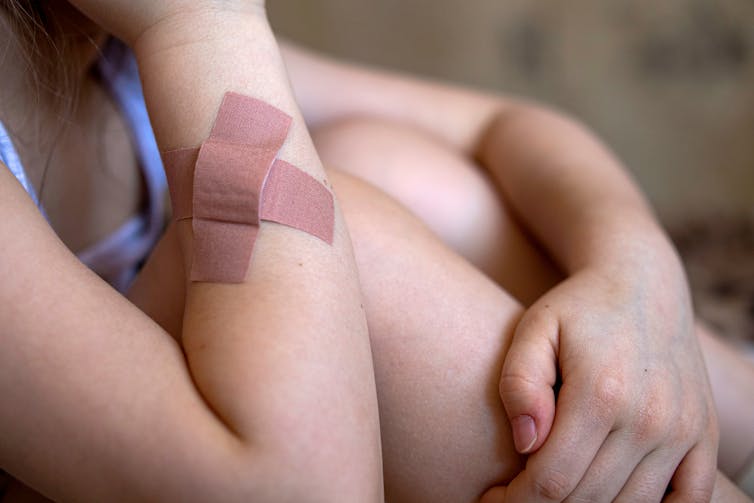Curious Kids: how do scabs form?
- Written by Christian Moro, Associate Professor of Science & Medicine, Bond University
How do scabs form? — Talila, aged 8
Great question, Talila!
Our skin has many different jobs. One is to act as a barrier, protecting us from harmful things in the outside world.
Sometimes when we cut or graze ourselves, we tear away some layers of our skin. When the skin is damaged, it can’t do its job of protecting us quite as well. What’s underneath the skin, called tissue, can be left exposed, and germs and other nasty things may get in.
So when we get a cut or a graze, it’s a race against time for our bodies to stop any bleeding, protect the area, and start the repair process. And this is where scabs come in.
Read more: Curious Kids: how do wounds heal?
What happens when you cut yourself?
To understand how this all works, let’s look at what would happen if you were to, say, graze the skin on your knee. You’ve probably done it before!
When you graze or cut yourself, blood vessels near the wound burst, causing you to bleed (blood vessels are the tubes which transport blood around your body).
Usually, if the wound isn’t too serious, it won’t be long before the bleeding stops. That’s because fortunately, our bodies have some clever ways of healing themselves.
 There’s a lot happening under that bandage: your body is working to heal itself.
Shutterstock
There’s a lot happening under that bandage: your body is working to heal itself.
Shutterstock
After you cut yourself, any damaged blood vessels quickly contract, closing some of their openings so that less blood flows out.
Next, tiny cells in your blood called “platelets” kick into gear. These platelets start to stick together, making a sort of plug that helps stop the bleeding and seal the cut. Other good guys in your blood also step in to help, working with the platelets to make the plug stronger.
Something called a “clot” then forms. This can block the damaged blood vessels completely for some time, giving the body a chance to start the healing process for both the skin and the vessels.
White blood cells, which help our bodies fight infections and diseases, also move into the damaged area. These cells work to kill any invading bad guys that may have entered your body through the wound, and help clean up the area.
Read more: Curious Kids: why do our toes and fingers get wrinkly in the bath?
Forming the scab
The clotted blood at the surface of the wound starts to dry out and forms a hardened scab. This may happen quickly, or take a few days.
This scab forms a protective layer, while allowing cells to move around underneath it so they can continue repairing the skin.
 As part of health-care training, scabs and scars can be painted on the skin using special effects makeup. This process is called ‘moulage’.
Christian Moro, Author provided
As part of health-care training, scabs and scars can be painted on the skin using special effects makeup. This process is called ‘moulage’.
Christian Moro, Author provided
If you have a scab, it’s best not to pick it or scratch it off. If you remove the scab while it’s still doing its work, you could expose the wound to the outside world, increasing the risk of infection or slowing down healing.
If you leave it alone, after about one to two weeks the scab will eventually fall off and reveal the new, repaired skin underneath.
Sometimes, depending on the type of tissue damaged or how serious the injury is, a cut to the skin can leave a scar. This is normal.
Scabs are good
So Talila, don’t worry if you have a small scab on your skin after a cut or graze. Scabs are one of the good guys; they protect your body and help your wound to heal.
Read more: Curious Kids: why do we have boogers?
Hello, curious kids! Have you got a question you’d like an expert to answer? Ask an adult to send your question to curiouskids@theconversation.edu.au
Authors: Christian Moro, Associate Professor of Science & Medicine, Bond University
Read more https://theconversation.com/curious-kids-how-do-scabs-form-151586




